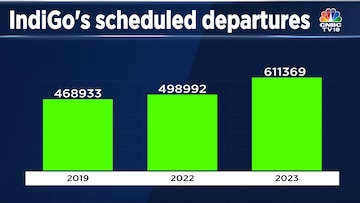
In September 2023, when engine maker Pratt and Whitney announced it would recall engines, several of which were on planes flying under the IndiGo banner, the street feared a huge hit to the operations of Interglobe Aviation, which operates the airline.
Seven months later, India's largest carrier has retained its domination with over 60% market share, operating about 2,000 flights daily to and from 88 domestic and 33 international destinations.

IndiGo remains the only Indian carrier to post six consecutive quarters of profits at the end of March 2024, the latest being a healthy Rs 1,894 crore.
With a profit of close to a billion dollars for the full financial year, the airline generously paid 1.5 months of basic salary as a special bonus to all its employees.

ALSO READ: Analysts raise target price on Interglobe shares but…
How has IndiGo sustained its growth at a time when nearly one in every five of its planes has been grounded?
According to data from a real-time flight tracking portal, Planespotter, on June 12, 79 of IndiGo's total fleet of 378 were grounded. The number of grounded planes has increased from about 40 in November 2023.
However, the airline carried 106 million passengers between April 2023 and March 2024, almost 21 million more than it did a year earlier.
A slight dip of 2.8% in market share since September 2023 pales in front of the over 60% market share the airline has maintained for at least a year now.
The airline quickly anticipated a possible seat shortage and added more planes to its fleet in good time, either by buying planes or leasing them (both wet and dry leases).
Explained: Difference between a wet lease and a dry lease
On a conference call after the latest earnings, Chief Executive Officer Pieter Elbers told investors that the airline added 65 new planes last year, nine of those were added in the last three months.
"With these additional aircraft and lease extensions that we had carried out, we were able to mitigate the adverse situation well and through all these measures," he added.
At the end of March, the airline had a plan ready to increase its capacity by 10 to 12% in the following three months.
IndiGo has ordered over 1,000 Airbus narrow-body aircraft, which arrive at the rate of one new plane every week. From 2027, 30 widebody planes, primarily meant for new international routes, will start arriving.
It's not just new planes; every plane is flying more routes and longer hours than before the pandemic. "IndiGo's aircraft utilisation, till 2019, was 14 hours daily. It has now grown to 18 hours a day," an industry executive told CNBC-TV18 on the condition of anonymity.
Another industry executive, who did not want to be named, shared a similar view: "If 370 planes were flying to 6 sectors earlier, then 300 planes are now operating in 8 sectors."
Nripendra Singh, an independent aviation consultant and a former director at consulting firm Frost & Sullivan, highlighted five factors that are helping IndiGo maintain its leadership.
"Compensation from OEMs (Pratt and Whitney) for grounded aircraft, extension of running leases, healthy seat load factors due to extended summer peaks. Besides, the revival of leisure sectors like Jammu and Kashmir, leading to higher average fares than ever, due to improved tourism conditions and better aircraft utilisation is what is aiding IndiGo's performance," Nripendra Singh said.
Diversification has also been an essential catalyst in IndiGo's overcoming a significant hurdle, such as the failure of Pratt and Whitney engines.
Another unnamed executive who's closely involved in aircraft maintenance explained that as early as 2020, IndiGo had bought planes with engines made by CFM, whose LEAP models power at least 150 of the airline's current fleet.
Seven months later, India's largest carrier has retained its domination with over 60% market share, operating about 2,000 flights daily to and from 88 domestic and 33 international destinations.

IndiGo remains the only Indian carrier to post six consecutive quarters of profits at the end of March 2024, the latest being a healthy Rs 1,894 crore.
With a profit of close to a billion dollars for the full financial year, the airline generously paid 1.5 months of basic salary as a special bonus to all its employees.

Interglobe Aviation, which operates the IndiGo airline, had a market capitalisation ₹1.7 lakh crore as on June 12.
ALSO READ: Analysts raise target price on Interglobe shares but…
How has IndiGo sustained its growth at a time when nearly one in every five of its planes has been grounded?
According to data from a real-time flight tracking portal, Planespotter, on June 12, 79 of IndiGo's total fleet of 378 were grounded. The number of grounded planes has increased from about 40 in November 2023.
However, the airline carried 106 million passengers between April 2023 and March 2024, almost 21 million more than it did a year earlier.
A slight dip of 2.8% in market share since September 2023 pales in front of the over 60% market share the airline has maintained for at least a year now.
The airline quickly anticipated a possible seat shortage and added more planes to its fleet in good time, either by buying planes or leasing them (both wet and dry leases).
Explained: Difference between a wet lease and a dry lease
| What is a wet lease? | What is a dry lease? |
| Aircraft taken on wet lease come with a crew and the operational control remains with the lessor. | With a dry-lease, the aircraft owner provides the lessee with an aircraft, without a crew and ground staff. |
On a conference call after the latest earnings, Chief Executive Officer Pieter Elbers told investors that the airline added 65 new planes last year, nine of those were added in the last three months.
"With these additional aircraft and lease extensions that we had carried out, we were able to mitigate the adverse situation well and through all these measures," he added.
At the end of March, the airline had a plan ready to increase its capacity by 10 to 12% in the following three months.
IndiGo has ordered over 1,000 Airbus narrow-body aircraft, which arrive at the rate of one new plane every week. From 2027, 30 widebody planes, primarily meant for new international routes, will start arriving.
It's not just new planes; every plane is flying more routes and longer hours than before the pandemic. "IndiGo's aircraft utilisation, till 2019, was 14 hours daily. It has now grown to 18 hours a day," an industry executive told CNBC-TV18 on the condition of anonymity.
Another industry executive, who did not want to be named, shared a similar view: "If 370 planes were flying to 6 sectors earlier, then 300 planes are now operating in 8 sectors."
Nripendra Singh, an independent aviation consultant and a former director at consulting firm Frost & Sullivan, highlighted five factors that are helping IndiGo maintain its leadership.
"Compensation from OEMs (Pratt and Whitney) for grounded aircraft, extension of running leases, healthy seat load factors due to extended summer peaks. Besides, the revival of leisure sectors like Jammu and Kashmir, leading to higher average fares than ever, due to improved tourism conditions and better aircraft utilisation is what is aiding IndiGo's performance," Nripendra Singh said.
Diversification has also been an essential catalyst in IndiGo's overcoming a significant hurdle, such as the failure of Pratt and Whitney engines.
Another unnamed executive who's closely involved in aircraft maintenance explained that as early as 2020, IndiGo had bought planes with engines made by CFM, whose LEAP models power at least 150 of the airline's current fleet.
First Published: Jun 12, 2024 9:39 PM IST
Check out our in-depth Market Coverage, Business News & get real-time Stock Market Updates on CNBC-TV18. Also, Watch our channels CNBC-TV18, CNBC Awaaz and CNBC Bajar Live on-the-go!
